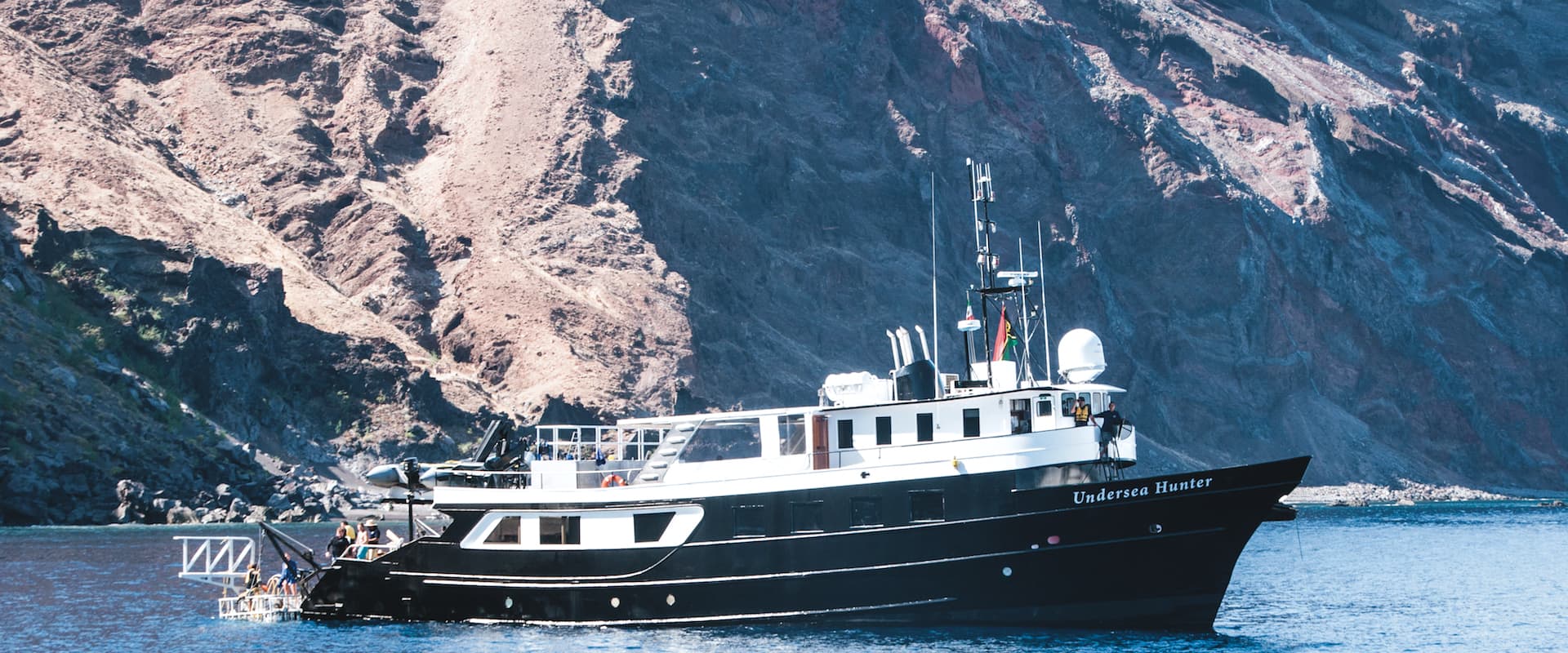Life on a Nautilus Liveaboard
The waters may get choppy on the full-day crossing to Socorro, but your Nautilus vessel’s steel hull and no-nonsense structure will stabilize your trip. Forget about the waves, and focus on fun and relaxation. Each of Nautilus’ three liveaboard yachts sports a hot tub on an upper deck, where you can also soak up the sun or relax in an al fresco lounge. For entertainment, besides the usual indoor screen and movie options, the crew organizes a “Theatre under the Stars” (an open-air cinema), and celebrates the end of the trip with a slideshow so that you can relive your special moments. For active types, kayaks and stand-up paddleboards are available. The food and beverages on the Nautilus fleet are highly rated by guest reviews, beaten only by the fleet’s 5-star average for customer service. Divers who have enjoyed a Nautilus journey can point to crewmembers by name for their unique and personal contributions to an excellent cruise; on the Nautilus website, you can read testimonials from previous passengers.
Diving with the Nautilus Fleet
Diving with the Nautilus fleet is all about the local wildlife; as such, the trips are scheduled to follow the natural rhythms of migration, breeding, and calving, which bring massive visitors to Baja California. Respect for these visitors, be they giant manta rays, humpback whales, whale sharks, or great whites, is a priority for the Nautilus team. To help you get the most out of your wildlife encounters and ensure the wildlife benefit from you, Nautilus liveaboards teach “Manta 101”, shark behavior, manta ID, and other conservation-friendly topics.
You’ll do an average of four dives a day and an optional night dive and night snorkel on Socorro itineraries. (The night snorkel uses floodlights to attract silky sharks!) All of the Nautilus vessels are rebreather-friendly, and the Nautilus Under Sea Liveaboard offers full service for oxygen, nitrox, and rebreathers. The Nautilus fleet maintains a storm policy to ensure bad weather won’t ruin your trip; see the website for more details about options.
Nautilus Vessels and Destinations
Baja California lies on Mexico’s Pacific coast, just south of the United States border; it’s extremely accessible but still a world away. The Nautilus fleet has made the area its own, encouraging customers to connect personally with the wildlife and landscapes of the region, including top-class wineries and the mystical Sonoran desert. Nautilus lovingly maintains three steel-hulled motor yachts to traverse Baja’s incredible waters, and they undergo regular refits and renovations. The Nautilus Explorer Liveaboard, their flagship vessel, was custom-built in 2000 to carry 25 passengers. The Nautilus Belle Amie Liveaboard is the biggest vessel, carrying 28 to 32 passengers with a bit of extra luxury. The Nautilus Under Sea Liveaboard was the Cocos Island-based Undersea Hunter in a former life, and the ship carries a worldwide fan base. The Nautilus Gallant Lady liveaboard is spacious and comfortable and, from May to October, is based in the northern Sea of Cortez at Bahia de Los Angeles, where whale sharks are often seen. From September to December, the boat moves south to the Cabo Pulmo marine park, known as a 'mini-Galapagos.' All four vessels are fitted with state-of-the-art open ocean satellite systems. Besides the obvious safety benefit of this infrastructure, guests can enjoy the internet and data on all boats. Each vessel holds a range of staterooms and suites on various floors. The most luxurious have their living rooms and windows, but all are beyond comfortable, with plush beds, high-quality sheets, and ensuite bathrooms.
Socorro Island is the most famous volcanic Revillagigedos archipelago land mass, attracting enormous marine life. The local chevron and jet-black mantas are famous for making eye contact with divers and hovering below or alongside them. You’ll also find 10 kinds of sharks (hammerheads, silkies, whale sharks, white tips, silver tips, Galapagos, and others) and migrating humpback whales. Unless there’s ash in the water from volcanic activity, visibility is 70 to 100 feet, perfect for experiencing some of the best big-animal encounters in the world.











